YARRAWONGA PILOT SUSTAINABLE REFURBISHMENT
Breathe Architecture
This project pushed the boundaries of what was “expected” from a University in terms of materials & finishes. It pushes for behavioural shift from its occupants. It leads, and with a bit of luck others will follow.
The brief was to design a sustainable refurbishment to set a new benchmark at Monash University. The project is to function not only as new offices but also as a demonstration to other faculties on how they might best execute a similar project.
In this case, the task was to refurbish an existing portable office building that had been relocated from Yarrawonga to the Clayton Campus in the early 80’s.
Located on the fringe of the campus lends to this idea of being forgotten, the issues were not just at an human or architectural scale, but also at a more encompassing urban scale.
With a considerable internal floor area of approximately 340square metres, the Yarrawonga Building houses a formal meeting room which is flanked by collaborative open office and private office spaces to the more private south end and informal meeting areas, reception, kitchen and breakout spaces to the more public north.
The main concept of the space was the idea of a caravan- a temporary building, which in some cases evolves into a more permanent structure with the addition of the annexe and flyover. These design initiatives greatly reduce the heat load of the existing portable building during the warmer months as it creates a second skin to the built form.
The west and east elevations of the façade of this flyover have been clad with a reinforcing mesh for climbers to grow upon – providing shade to the existing building during the warmer months.
There is a sprinkler system intended for the climbers which will further assist with cooling, by the way of evaporative cooling. This living, green façade or ‘Green Sleeve’ in tandem with the shading provided by the roof are key passive techniques to reducing heat load on the building.
Internally, the building’s thermal performance was poor; it was for this reason that Breathe decided to insert a ‘Green Sleeve’ internally. This meant retaining the existing external wall, floor and roof structure, creating another insulation cavity and lining it with recycled floorboards and masonite panelling.
INITIATIVES
-
Passive solar design – reduce heat gain on existing building in summer by building secondary shading roof over existing building. The walls of this structure are lined with reinforced steel mesh for vines to grow and to establish a ‘green sleeve’ to shade the western façade from the warm afternoon sun. This ‘green sleeve’ also helps deal with the radiant heat that is emitted from the adjacent car park.
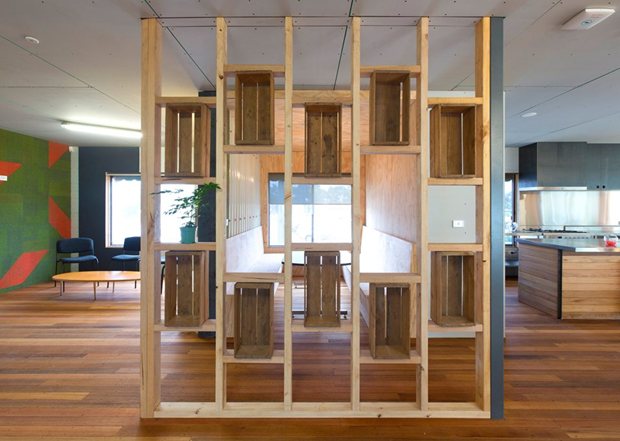
-
Natural day lighting – encourage natural daylight penetration by installation of north facing glazing as well as office areas receiving filtered light during summer and increased daylight during winter through ‘Green Sleeve’(reducing electricity demand for artificial lighting).
-
Cross ventilation – design of open plan spaces with shared meeting spaces with shaded windows to promote air movement.
-
Super insulation - secondary insulation skin to the walls, ceiling and floor. Entry has been pushed out external of existing building to provide an airlock.
-
New products specified contain low embodied energy by using recycled materials and materials close to their natural state. Use of unnecessary finishes such as chrome and paint were avoided where possible, reducing the embodied energy involved in manufacturing of products.
-
Off the shelf products used in conjunction with simple pre-fabricated construction techniques – the portal frame was assembled in a factory, reducing wastage and was transported to site, travelling less than 11km.
-
Hydronic heating radiators installed throughout building with a highly efficient Gas boosted water supply.
-
Energy Efficient Compact Fluorescent lighting in conjunction with space sensors and a master switch.
-
Sustainable transport – bike parking for 14 bicycles on entry ramp with 8 additional bike parks occupying what were two car parking spaces.
-
Rainwater harvesting – 5 x 1000 litre water tanks supply toilets & landscaping irrigation
-
Double glazing – Sliding Perspex panels installed inside existing windows to provide affordable double-glazing solution.
-
Low toxicity materials – no glues used on this project (nail & screw fixings only) wax finish to floors, zero VOC paint made in Australia from recycled engine oil.
-
Recycled Carpet Tiles – Donated to the project, these used carpet tiles where fixed to provided acoustic attenuation in certain areas as well as serve as pin boards for the office spaces.
-
Local plantation timbers – Australian Masonite and Weathertex wall linings, pine framing, & formply / plywood benchtops.
-
Local Recycled & Remilled Timbers – Recycled Tasmanian Oak and Brushbox used for flooring, which came from 5 demolished house lots and 1 Gymnasium. Remilled Blackbutt decking and ramp installed without finish.
-
Furniture has been re-used from other sites on campus as well as the use of GECA certified task chairs made locally.
-
Reduction of wastage by monitoring waste to landfill.
-
Billi ‘Eco’ Chilled and Boiling water system installed in the kitchen.
-
A preliminary Green Star Rating was undertaken by ‘The Office of Environmental Sustainability’ of Monash University showing the project with 5 Stars.
-
Perspex sliders were fitted internally to all existing large sliding windows, as a low-tech double-glazing system.
-
The building is naturally cooled via cross ventilation and wall mounted fans. This is augmented by a thermostatically controlled air conditioning system that only operates when the internal temperature reaches 27°.
-
Melbourne is a city for which the majority of the year is actually cooler. It is for this reason that all these insulative qualities of the building also act to retain heat that is within the building envelope during winter. The space is heated via Hydronic heating radiator panels and a high efficiency boiler.
-
Due to the restrictive budget, priority was given to using passive, efficient and affordable heating and cooling solutions that not just perform and respond to the local environment, but also inform, educate and provide precedence for how we should approach design and sustainability into office spaces.
-
Reduction of wastage by monitoring waste to landfill. Records were kept for purposes of Green Star accreditation.
-
Reduce wet trades and toxic glues (There was no plaster, paint or tiling specified for the walls or ceiling linings of this project).
-
Re-use of timber skirting and architraves for various details.
LEIGHTON HQ
Conrad Gargett Architecture
The brief called for a space that promoted open communication and teamwork, both horizontally and vertically within the organisation.
The aim of demonstrating world leadership in the field of sustainability was not to be achieved at the expense of functional and operational requirements.
In response to this, an early commitment was made to introduce a series of strategically placed voids and shared spaces which promoted strong connections and open communication, as well as distribute natural light deep into the tenancy.
The client requirement for a high ratio of enclosed offices presented significant challenges. Enclosed spaces create a range of obstacles for sustainable design, in particular the areas of energy consumption, light distribution, access to views and daylight, HVAC systems and material usage are heavily impacted.
As an integrated fit-out, each ESD initiative also had to be balanced out against the base build design plans to achieve 6 star, and where overlap occurred negotiation and adaptation was required. How has the project addressed energy, water and resource efficiency:
INITIATIVES
-
The project achieved all 16 available energy related points with the rating tool.
-
It has achieved a 67per cent CO2 reduction on 5 star NABERS rating.
-
A BMS facilitates extensive monitoring and control over energy and services use.
-
One innovative feature programmed is the ‘master power shutdown sequence’ which warns users (and gives opportunity to override in a particular zone), through the lighting system, of daily programmed powering down of all major electrical items including lighting, computers and equipment.
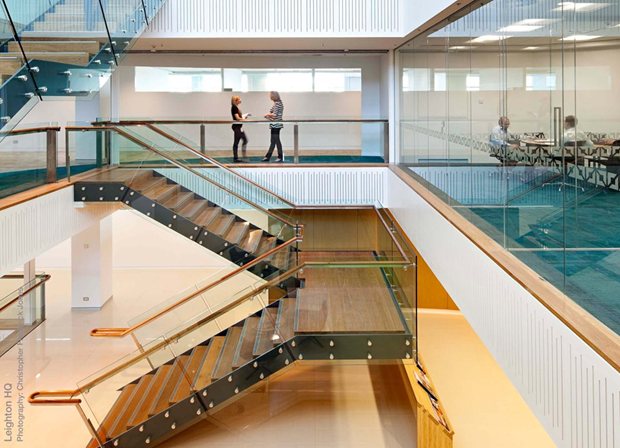
-
The tenancy also connects to the innovative ‘co-generation’ plant on site.
-
Rainwater collection tanks installed in the basement are used for the watering of a green wall, plants and toilet flushing. Ongoing water consumption monitoring is also being undertaken.
-
Resource efficiency is evidenced throughout in the re-use of furniture, minimisation of waste, use of recycled materials and material minimisation.
-
Products were frequently tested against multiple standards. For example, furniture met both the stringent GECA standard and additional volatile organic compound emissions standards.
-
New and innovative products such as PVC free data cabling and super E0 board were actively sourced.
-
Everyday building products were also used to achieve innovative outcomes. Glazing was strategically placed at the front and back of offices to distribute natural light throughout the entire fit-out. This combined with light, yet durable, materials, individual LED desk lamps and automated blinds allowed the client to reduce reliance on artificial lighting further than was considered possible at the modelling stage.
-
Many products used within the fit-out have a high recycled content, in particular the carpet, furniture, wall linings, ceiling tiles and timber.
-
The client reused and refurbished a significant proportion of existing furniture and equipment.
-
Over 80per cent of the waste created during construction was re-used or recycled.
-
The ongoing recycling system put in place starts with specialty recycling bins at each desk through to common areas and recycling centres within the tenancy.
PAPER STONE SCISSORS
Russell & George
The creative brief for Russell and George was to turn a two dimensional surface into a three dimensional reality. Metaphorically, paper “peels” throughout the fitout, stone in the cliff like stair and entrance foyer, and scissors, referencing the “cut” of three dimensional Japanese paper art. The client’s budget was very low and there was significant upgrade required of the existing building to bring it up to the current NCC. The existing building was separated into three separate tenancies spread over 4 levels, all with individual stair cases, and designed as a celebration of 1980s Post Modernism. To keep the costs down, all existing floor levels were retained, a void was opened at the entrance, and a new stair was inserted connecting all levels.
This stair also provided a strong visual identity and increased the visual scale of the entrance foyer. Service strategy throughout the building was to retain and re-use wherever possible, all new wet areas to be back to back over the various levels. This also minimised trenching and invasive works, and reduced the overall hydraulic costs.
INITIATIVES
-
Existing walls, surfaces and glazing was all retained.
-
The mechanical system was completely segregated, which meant that zones can be turned on and off as required.
-
The existing fabric meant that natural cross ventilation was possible as an alternative to mechanical air conditioning when the weather permitted.
-
Reclaimed and recycled timber was specified wherever possible.
-
From the front door where the door handles roll like a sheet of paper revealing a white onyx stone inlay that glows at night, to the corner wall peels and their integrated lighting. Spaces are regular, but irregular, like the main stair that cascades through all floors and peels away at the edges.
-
Paint and colour were used in a very simple and monochromatic way, turning two dimensional surface into three dimensional super graphic.
-
Dulux White Watsonia is used in the foreground,
-
Background palette of raw brick and recycled timber.
-
The stair and entry foyer act as an anchor in the large open warehouse volume.
-
The tenancy also connects to the innovative ‘co-generation’ plant on site.
-
Rainwater collection tanks installed in the basement are used for the watering of a green wall, plants and toilet flushing. Ongoing water consumption monitoring is also being undertaken.
-
Resource efficiency is evidenced throughout in the re-use of furniture, minimisation of waste, use of recycled materials and material minimisation.
-
Products were frequently tested against multiple standards. For example, furniture met both the stringent GECA standard and additional volatile organic compound emissions standards.
-
New and innovative products such as PVC free data cabling and super E0 board were actively sourced.
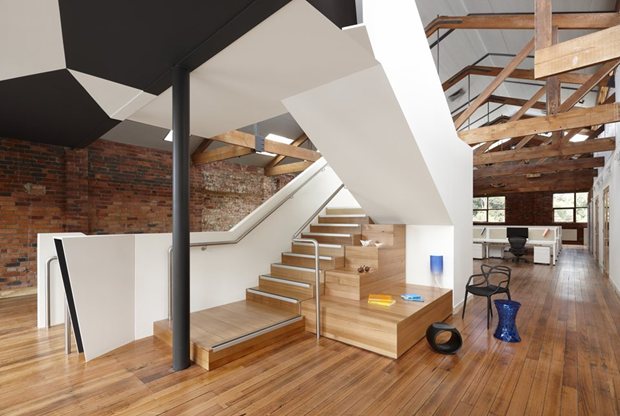
-
Everyday building products were also used to achieve innovative outcomes. Glazing was strategically placed at the front and back of offices to distribute natural light throughout the entire fit-out. This combined with light, yet durable, materials, individual LED desk lamps and automated blinds allowed the client to reduce reliance on artificial lighting further than was considered possible at the modelling stage.
-
Many products used within the fit-out have a high recycled content, in particular the carpet, furniture, wall linings, ceiling tiles and timber.
-
The client reused and refurbished a significant proportion of existing furniture and equipment.
-
Over 80per cent of the waste created during construction was re-used or recycled.
-
The ongoing recycling system put in place starts with specialty recycling bins at each desk through to common areas and recycling centres within the tenancy.
SMART GRID SMART CITY INFORMATION CENTRE
Schreiber Hamilton Architecture
Following being awarded the Federal Government’s Smart Grid – Smart City (SGSC) Project, an initiative to research and gather information about the costs and benefits of smart grids to inform future policy making, Ausgrid was charged with the responsibility of rolling out of new smart technologies across the network to improve the reliability of electrical supply and help reduce the cost of maintaining the network.
A key to this initiative was informing the community of current and future sustainable energy possibilities and initiatives. To enable this in the Hunter Region, Ausgrid partnered with Schreiber Hamilton Architecture, APP Project Management and Hansen Yuncken Builders to bring to life a physical storefront to showcase the future of sustainable energy.
The design objective of the Smart Grid, Smart City Information Centre was to provide a showcase for efficient, sustainable design aimed at "mum and dad" home owners and home buyers, small to medium business owners and community groups. It was to provide public facilities to showcase energy sustainability information, options and products, and to include interactive exhibition displays promoting examples of sustainable energy-efficient technology.
In particular this was to be aimed at the mass-market housing demographic.
The Smart Grid Smart City Information itself is an example of sustainability, and SHA included many examples of recycled and energy efficient materials and technologies into the architecture of the project.
As a showcase project for sustainability, the design called for a higher than normal level of included sustainable technologies, products and features, and this had to be integrated into a modern, consumer friendly, state of the art setting so that customers and visitors could see, hear and feel the message that energy sustainability is affordable, attractive and a viable and available option for energy consumers.
To bring this concept to life as a built environment, SHA and Ausgrid envisaged a centre that acted in harmony with its message and so the Smart Grid Smart City information Centre includes many energy efficient and water efficient materials and technologies, adding an extra level of detail to the sourcing of fittings and fixtures while still keeping to a strict budget.
INITIATIVES
-
Natural light and ventilation opportunities have been maximised to reduce reliance on artificial lighting, minimise energy consumption and take advantage of the temperate climate.
-
The Centre utilises natural light, and is supplemented by a range of low energy lighting options. Lighting products were chosen with energy efficiency in mind and most are connected to control systems which reduce energy use when the Centre is closed.
-
Water-efficient taps and toilets are installed in the bathrooms. The 6 star WELS rated taps use just 4.5 litres per minute. The dual-flush 4 star WELS rated toilets use recycled water, collected from the roof of the building and treated for use in non-potable water tanks in the basement. These toilets use only 4.5 litres for a full flush and 3 litres for a half-flush.
-
An interactive shower display shows users how much water is wasted by inefficient shower heads. The display is served by a high-efficiency water reuse system, including filter and UV light anti-bacterial system.
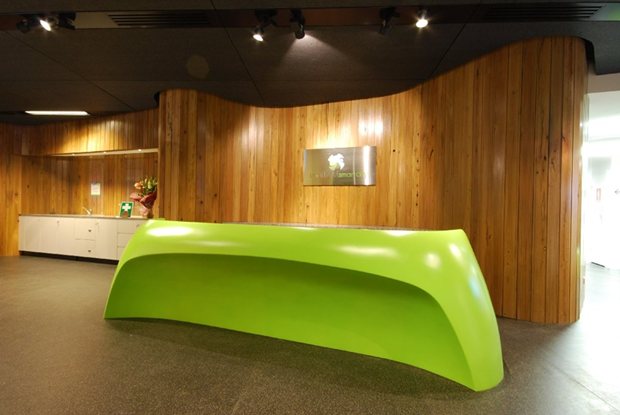
-
The built form of the project includes individual energy-efficient and water-efficient exhibition display suites throughout the Information Centre.
-
Car parking for the Information Centre, utilises existing tenant basement parking, augmented with electric vehicle charging points for Ausgrid's fleet of MIEV electric cars.
-
Floors: Recycled rubber resilient sheeting, incorporating recycled car tyres and other recycled rubber materials. Bamboo engineered flooring which is highly durable, harvested from sustainable sources, non toxic and includes low VOC adhesives and coatings.
-
Walls: Feature timber wall fabricated from Ausgrid recycled power poles and milled to a custom profile and then “scribbled” across the rear wall of the tenancy.
-
Ceilings: Echopanel acoustic panels, produced from recycled and recyclable PET plastic (with approximately 60per cent of PET sourced from post consumer waste materials).
-
Bench tops: Engineered stone with post manufacturing waste materials incorporated as a recycled element.
-
Joinery: Exhibition joinery incorporates X-board Kraft as carcassing, which is a sustainable alternative to MDF, and recyclable at end of life. It is ideal for the relatively short intended design life of the exhibition displays.
-
Demolition and preparation of the tenancy was undertaken in a manner that allows simple reinstatement at the conclusion of the tenancy.
-
Daylight mesh stacking chairs are partially constructed from recycled car batteries, which can be recycled at the end of their life.
-
The project includes a very high content of recycled materials, including
-
Feature timber wall fabricated from Ausgrid recycled power poles and milled to a custom profile.
-
Engineered stone bench tops incorporating 42per cent recycled materials recovered from production waste material.
-
Echopanel acoustic panelled ceiling, produced from recycled and recyclable PET plastic (with approximately 60per cent of PET sourced from post consumer waste materials).
-
Recycled rubber resilient floor sheeting, incorporating recycled car tyres and other recycled rubber materials.
-
Bamboo engineered flooring which is highly durable, harvested from sustainable sources, non toxic and includes low VOC adhesives and coatings.
-
Joinery items include X-board Kraft for internal structure, a material which contains recovered paper waste and sugar-cane fibres.
-
In the 60 seat auditorium space, Daylight mesh stacking chairs are partially constructed from recycled car batteries. They can also be recycled at the end of their life.
DEPARTMENT OF EDUCATION, EMPLOYMENT AND WORKPLACE RELATIONS
Woodhead Pty Ltd
Woodhead designed the DEEWR interior as an integrated fitout ensuring all design features and innovations were seamlessly incorporated into the final built form.
The Woodhead design team responded to the DEEWR client brief with a design concept which creates an environment that engages human emotions and experiences in a living space, and is responsive to the Canberra surrounds.
“The modern office has evolved to become a place where the boundaries of work life and home life have blended. It has become a meeting place”.
The interior planning of the large floor plates are designed with a modular approach. Room sizes are based on a 3.6 x 3.6m module, with offices and meeting rooms being either one, one and a half, or two times this module. Together with the use of demountable partitioning, future re-configuration will be much easier, quicker and more ecologically sustainable than in the client’s previous accommodation.
The interior design included delivery of over 40,000sqm of office workspace across 12 levels.
The building and the fitout has exceeded the government policy for leased office accommodation. The base building has achieved a certified 6-Star Green Star Office As Built building, and has been recognised as being highly energy efficient and sustainably responsible. The fitout is also certified as a 5-Star Green Star Office Interiors v1.1 rating.
All materials, furniture, fixtures and fittings have been selected for their environmentally sustainable criteria.
Each floor features a large living plant wall. The plants decrease the amount of carbon dioxide in the office environment, increasing the oxygen levels, and hence providing a healthier workplace. The specially selected plants act as a natural filter for indoor air, removing airborne contaminants.
The new fitout facilitates an environment which improves productivity and quality of life through connecting people and giving people different ways to do their work. .
The investment in a range of technologies such as the theatrette and video conferencing allows DEEWR to communicate in a range of new ways. Real time, interactive communication provides DEEWR with tools necessary for improved collaboration with staff, customers and key stakeholders across the country. These technologies also reduce the requirement for travel, decreasing DEEWR’s carbon footprint.
INITIATIVES
-
The tenancy achieves at least a 5 Star NABERS (formerly ABGR) rating, with an additional 20per cent CO2 reduction.
-
Sub-metering is installed for tenancy lighting and small power consumption.
-
Sub-metering is installed for substantive energy uses within the tenancy.
-
Individual switches are installed for enclosed spaces and zones in accessible locations. Further, 95per cent of the Net Lettable Area (NLA) contains an individually addressable lighting system
-
The project includes rainwater collection and a greywater treatment system in the basement.
-
The use of potable water is greater than a 'best practice' scenario.
-
A tri-generation system is provided in the Level 12 Plantroom, providing on site generation of electrical energy using a gas fired engine and utilising the waste heat from the engine to produce cooling water or heating hot water which is used for space conditioning and the domestic hot water system.
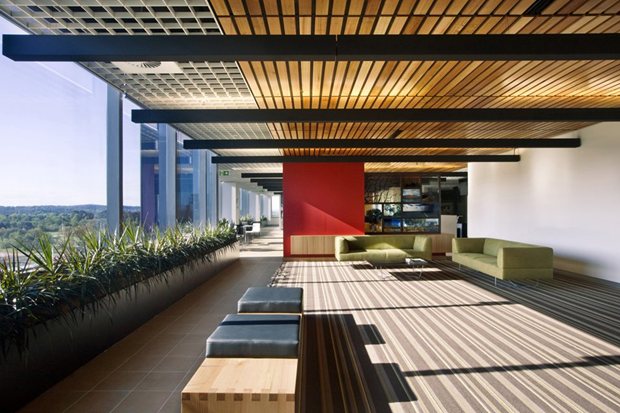
-
The flexible modular fitout provides DEEWR with improved ways in which it can manage future accommodation needs in a way which is efficient, cost effective and, through the reuse of demountable partitioning, is environmentally responsible.
-
The investment in a range of technologies such as the theatrette and video conferencing allows DEEWR to communicate in a range of new ways. Real time, interactive communication provides DEEWR with tools necessary for improved collaboration with staff, customers and key stakeholders across the country. These technologies also reduce the requirement for travel, decreasing DEEWR’s carbon footprint.
-
Each floor features a large living plant wall. The plants decrease the amount of carbon dioxide in the office environment, increasing the oxygen levels, and hence providing a healthier workplace. The specially selected plants act as a natural filter for indoor air, removing airborne contaminants.
-
All materials, furniture, fixtures and fittings have been selected for their environmentally sustainable criteria.
-
The interior planning of the large floor plates are designed with a modular approach. Room sizes are based on a 3.6 x 3.6m module, with offices and meeting rooms being either one, one and a half, or two times this module. Together with the use of demountable partitioning, future re-configuration will be much easier, quicker and more ecologically sustainable than in the client’s previous accommodation.
-
An Environmental Management Plan (EMP) was implemented in accordance with Section 4 of the NSW Environmental Management System Guidelines during construction. The builder held ISO14001 accreditation applicable to the construction works of the building.
-
The builder implemented a Waste Management Plan and 80per cent of construction waste by weight was re-used or recycled during fitout works.
-
Walker Corporation as the developer and owner of the building was acutely aware of their long term investment.
-
Detailed energy modeling was undertaken which was reflected in the outstanding achievement of a 6 Star ABGR Design rating.
-
This is the first Australian Federal Government project in the ACT to achieve a 5 Star Green Star Office Interiors V1.1 rating.
GPT BUILDING
Woods Bagot
GPT is a property group with broad access to capital investment in quality assets which, through proactive management, creates great customer experiences and superior returns.
GPT workplace in the MLC Centre, aimed to set new standards in retrofit projects and to challenge the preconceived restraints of older, smaller floor plate, central corebuilding stock.
The brief was to create a workplace that aligned with the cultural aspirations of GPT, to connect the business back to the community, to ‘reinvigorate’ their space, their asset, the GPT culture and approach to work. The new working environment allows for business growth and optimises performance by providing task orientated wireless and technologically enabled spaces, allowing employees to utilise a range of settings from concentrated private spaces to collaborative and project specific settings, coupled with a broad range of meeting rooms.
The project was challenging as the MLC Centre had not undergone a major base building refurbishment over its 30 year lifespan, even though it has a 5 star NABERS rating. GPT’s tenancy at 3600 sqm represents only a small portion of the overall NLA in the building and as such the design team had to work extremely hard to create a ‘green infrastructure to support a small tenancy” and to rework the building services.
The design honours and interprets the building’s heritage and Siedler’s forms and uses these forms in the ceiling and also in the two statement staircases. The subtle combination of exposed and concealed ceilings, help to create relief in the ceiling plane and ‘breaks’ the monotony of the reduced ceiling height and standard ceiling grid of a regular office tower.
The GPT fitout materials strategy, is a methodology that was developed as a part of the GPT tenancy fitout which informs GPT’s wider materials procurement and waste diversion strategy across their entire portfolio. The sustainable materials strategy is twofold, an existing materials strategy (to maximise waste diversion) followed by a new materials strategy (for material reuse and procurement)
INITIATIVES
-
From a services perspective there is an increase in fresh air rates internally to provide 11.25 litres/sec/person to push delivery to be 50per cent above the requirements of AS 1668.2-1 991 by 50per cent (equivalent to 11.25l/s/p). This is augmented by the introduction of 500 plants, that promote a feeling of ‘fresh’ and clean air, which is as much about user perception as it is about impact on the internal air quality. .
-
The lighting strategy looked at reducing the overall lighting level to below the recommended Australian standard in circulation spaces and provided task lighting to augment focused task areas.
-
The external bays of lighting are on PIR to reduce lighting levels when the daylight level is sufficient.
-
GPT has implemented an alternate working environment with 270 desks for 320 users, this in itself is a sustainable use of space and resources.
-
Has 90per cent less paper stored
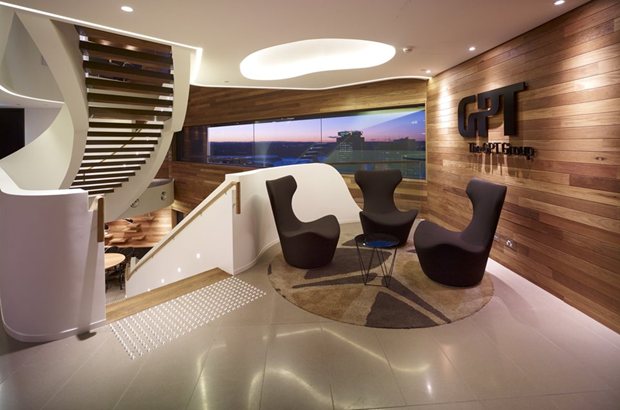
-
Uses 75per cent less paper
-
Uses 50per cent less energy
-
Lighting energy consumption is down by 70per cent
-
Fresh air intake increased by 25per cent with the addition of external louvres into the façade
-
500 plants were added
-
12 months occupied at 14 June 2012
-
320 lockers/272 desks. The 272 desks are generally only 77per cent occupied
-
100per cent of pre-existing equipment and fitout materials were either recycled or re-used
-
Staff moved from being spread across five floors to being consolidated across three floors
-
A more mobile and engaged workforce.

